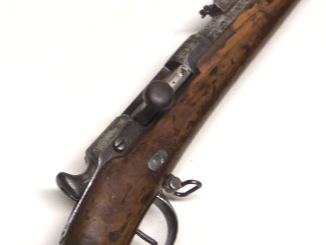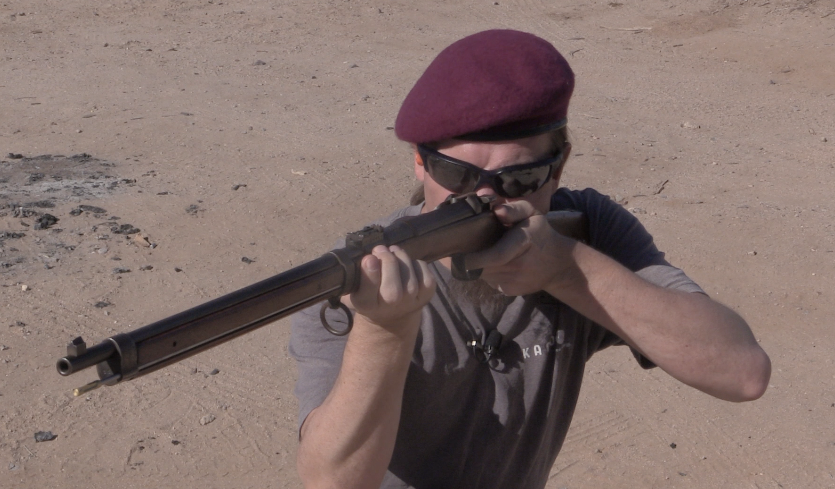A while back, I ran a 2-Gun match on my own with my MAS 49-56 (and a plain Glock 19), including the original APX L806 optic. It was not a particularly complex match, but it was fun to give the 49-56 a whirl.
Takeaways:
– The 10-round magazines of the MAS family are definitely a hindrance in competition. Both the small capacity and the very slow nature of the period web gear, thanks to the external magazine latches.
– The trigger is also not very good.
– The APX L806 optic is good and durable, and does allow use of iron sights while mounted. It has a fairly small field of view by modern standards, which can be a problem at closer ranges.
My final score was 30th out of 40 shooters.




Sounds like Ian had better days.
The MAS-49/56 fascinated me because it was a modern service rifle with a built-in rifle grenade launcher and the standard rifle was designed to use a telescopic sight. Ten rounds was almost the standard for semiautomatic service rifles. The 20 shot magazine standard for the G-3, FAL and M14 was due to those rifles being intended for the automatic rifle role, unlike the SAFN or MAS-49 and MAS-49/56. Wasn’t the prototype Garand designed for ten rounds of .276?
More data on what works in two-gun matches!
“(…)The 20 shot magazine standard for the G-3, FAL and M14 was due to those rifles being intended for the automatic rifle role, unlike the SAFN or MAS-49 and MAS-49/56.(…)”
Also, both G3 and FAL have inter-mediate cartridge ancestors. FAL before being chambered 7,62×51 NATO was chambered for 7×43 mm cartridge, see 1st photo from top:
https://modernfirearms.net/en/assault-rifles/belgium-assault-rifles/fn-fal-l1a1-c1-slr-eng/
G3 was derived from CETME-designed rifles, which themselves were preceded by prototype chambered for experimental 7.92x40mm cartridge see 2nd photo from top:
https://modernfirearms.net/en/assault-rifles/spain-assault-rifles/cetme-mod-a-b-58-c-eng/
Both were prototyped in the 7,9×33 mm kurz patrone too!
According from a French weapon group on FB ( Cellule Mire ) the rubber butt comme in 2 length allowing the user to “tailor” the length of pull to his size.
Now Mr. M’Collum has to do this over again but reload through the top of the receiver with chargers/stripper clips! Ha! And now he can use a French service pistol too, I expect.
The time element in these matches reminds me of Cowboy Action shooting.
Perhaps Mr. M’Collum might add a dummy rifle grenade launch to the match, which would of course give him an advantage over the other “run-‘n’-gunners?”
Some viewers north of AZ have trick to keep the gravel off your elbows when prone. We call it snow. Although kneeling is preferable. 🙂 Many days hats aren’t optional.
– I am curious what the Garand in .276 capacity was? 10 rounds makes sense, did any country perform a trade analysis: weight, number of rounds, etc to arrive at this or 10 rounds just seemed about right? Likewise ~25 rounds for STG44, and 20 then 30 rounds for M16?
– Always wondered how the magazine catch on the magazine affected usage on the MAS 49 family…thanks for the data point. I always thought the reason why it didn’t catch on (no pun intended), was that it increased the price of the magazine.
– My if Ian does this again with a contemporary french pistol, I would suggest a MAB PA-15. On one hand I’ve heard it has heavy recoil, which sounds counter-intuitive given the over-engineered construction.
John Cantius Garand’s .276 Pedersen-caliber rifle was a ten-shot rifle. It had “any side up” en block clips loaded with ten cartridges. The rifle itself was svelte, lighter, etc. But Douglas MacArthur reasoned that since the U.S. ammunition stocks were in .30-06, and U.S. MGs were in .30-06, and ammunition manufacturers could make more .30 caliber ammunition but not immediately .276 caliber, that the caliber of .30-06 had to be retained. And so it was. The U.S. rifle, caliber .30 M1 (Garand) was thus heavy, and only 8-shots.
Recall, Gaston, that the metric system makes for a nice “round number” of ten… ten fingers, ten toes, etc. The Sørensen Bang prototype offered to U.S. Ordnance had a magazine capacity of 7. The M1 carbine had a magazine capacity of 15, although presumably fewer cartridges were loaded. In the case of the Bren gun, the magazine was loaded with 28 cartridges rather than 30. For much of the Vietnam War, both the M14 and M16 used 20 round magazines. Anecdotes suggest that many U.S. soldiers only loaded 18 rounds in the magazine. From very early, there were requests for parity with Kalashnikov magazines, and having 30 round magazines issued. These did not start to appear until 1969.
The French FAMAS F1 has a 25-round magazine. The Israeli Galil had a 35-round magazine. Once the AR/M-16 30-round magazine became the STANAG Nato standard, then the 30-round M-16 began to appear in many other rifle designs for 5.56x35mm rifles.
I’m not sure if Ian can find a 9 mm French service pistol. These are a bit rare and costly over in the US.
The M1 Carbine originally was supposed to have both 20 shot and 50 shot magazines–matching the Thompson submachine gun. The 1941 handbook by James E. Hicks grandly titled “What the Citizen Should Know About Our Arms and Weapons” described the M1 Carbine on page 97 thus: “Feed–two sizes of clips may be used, one holding twenty cartridges and one holding ten cartridges.” The text stated that the 1941 infantry regiment was armed with 1,181 pistols plus the other regimental weapons; the plan was to change this to 944 carbines and 237 pistols, increasing the regiment’s firepower. Part of the firepower increase was having a shoulder weapon with 300 yard effective range (the pistol at the time was “effective” to 50 yards) and the pistol’s magazine was 7 rounds–when the soldier was issued more than five pistol cartridges and perhaps even more than one magazine. M1 Carbine magazine capacity wasn’t fixed at 15 rounds until the last minute, and then when the automatic fire capability of the original specifications was added to the M2 Carbine, the 15 shot magazine was too small for more than a second to a second and a half of full auto fire. The 30 round M2 Carbine magazine didn’t provide three full seconds of automatic fire and it wasn’t practical to fit the M2 carbine with a rate reducer to bring the cyclic rate to around 400 rounds per minute (like the M3 Submachine Gun and the slow automatic fire rate of the M1918A2 Automatic Rifle) so the “solution” was to provide four or five 30 round magazines.
The AR-15 was intended to fire semiautomatic most of the time with full-auto fire reserved for “emergencies,” whatever that meant. The prototype AR-15 had 25 round magazines but this was reduced to 20 rounds before mass production began.
Looking into the pre-production prototype history can be surprising. If the M1 Carbine had 20 shot magazines, would there have been 30 shot magazines? If the M16 had 25 shot magazines, would that have been “upgunned” to 30 shot magazines?
What if the Army had specified a 350 rounds per minute cyclic rate for the M16 before adoption?
What would make it a “French service pistol?”
The P-38 was used for a short time post-war by the French Army:
http://pistole38.nl/the-p38/postwar-french
https://medium.com/war-is-boring/after-world-war-ii-france-had-too-many-different-pistols-2ff3cccd9a6
https://www.guns.com/news/review/gun-review-manurhin-p1-9mm-parabellum
https://www.rockislandauction.com/detail/72/3481/excellent-french-mauser-svw45-code-p38-semiautomatic-pistol
A Manhurin-marked P1 or P-38 is “French,” but is it French enough?
Very true… Late in WWII and into the occupation of defeated Germany, the resumption of colonial war in Vietnam/ Indochine saw France possessed of a very, very wide assortment indeed. Good point. The P-38 is certainly widely available.
I have a quick question would the French soldiers have been issued stripper Clips or would they have had extra mags
Stripper clips would have been issue, but the reality is both were increased. The rifles were supplied with a fixed number of mags, I believe 4, though my memory is hazy. The Legion increased their load by “losing” their mags and getting replacements. It wasn’t unusual for a soldier to have 10-12 mags plus the corresponding load out of stripper clips. Also the French did try to correct this issue by supplying 20 round magazines later on. The problem is that only caused the Legionnaires to only reduce the load out to 8-10 magazines followed by a corresponding number of stripper clips needed to reload which in turn increased the overall combat load rather than reduced it.